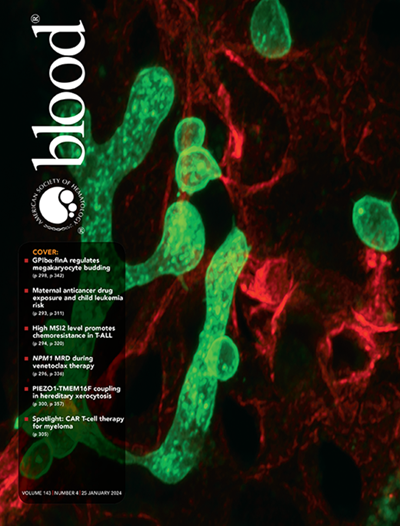新一代测序对新诊断多发性骨髓瘤患者的高风险基因组共识验证。
IF 23.1
1区 医学
Q1 HEMATOLOGY
引用次数: 0
摘要
多发性骨髓瘤的预后异质性主要由骨髓瘤细胞的基因组特征驱动。国际骨髓瘤学会(IMS) /国际骨髓瘤工作组(IMWG)最近提出了一个高风险(HR)基因组模型,以便对基因组风险的定义达成共识。我们在2019年至2024年间对6528名新诊断的骨髓瘤患者(NDMM)和1583名首次复发的患者进行了NGS检查。根据共识基因组分期(CGS),我们观察到诊断时22.4%的患者和首次复发时36.7%的患者为HR。2695例患者在诊断时可获得临床资料。中位随访35个月后,HR NDMM患者的中位PFS为30个月,而标准风险(SR)患者的中位PFS为51个月(p<0.0001)。来自修订的iss评分的HR细胞遗传学标准不能区分HR和SR IMS/IMWG基因组亚组的患者。独立观察每个标准,我们发现del(17p)、TP53突变、双等位基因del(1p32)或中间风险细胞遗传学(gain 1q、del(1p32)、t(4;14)、t(14;16)、t(14;20))的存在与标准风险患者相比显著降低了PFS。此外,累积多项标准的患者预后更差。在基因组定义肌酐正常的SR患者中,β -微球蛋白水平高的患者的中位PFS与β -微球蛋白水平正常的患者无显著差异。该研究在2019年诊断的大量患者中验证了IMS/IMWG对高危骨髓瘤的基因组定义。本文章由计算机程序翻译,如有差异,请以英文原文为准。
High-risk genomic consensus validation for patients with newly diagnosed multiple myeloma using next-generation sequencing.
The prognostic heterogeneity of multiple myeloma is mainly driven by genomic features of myeloma cells. The International Myeloma Society (IMS) / International Myeloma Working Group (IMWG) recently proposed a high-risk (HR) genomic model in order to have a consensus definition of genomic risk. We performed NGS panel in 6528 new diagnosed myeloma patients (NDMM) and 1583 patients at first relapse, between 2019 and 2024. We observed that 22.4% of patients at diagnosis and 36.7% at first relapse were HR according to the Consensus Genomic Staging (CGS). Clinical data were available for 2695 patients at diagnosis. After a median follow-up of 35 months, the median PFS was 30 months for HR NDMM patients, vs 51 months for standard-risk (SR) (p<0.0001). HR cytogenetic criteria from the Revised-ISS score were not able to discriminate patients in HR nor SR IMS/IMWG genomic subgroups. Looking at each criteria independently, we found that the presence of del(17p), TP53 mutation, biallelic del(1p32), or the combination of intermediate risk cytogenetics (gain 1q, del(1p32), t(4;14), t(14;16), t(14;20)) significantly reduces the PFS compared with standard-risk patients. Moreover, patients cumulating several criteria had an even worse prognosis. Among SR patients according to the genomic definition with normal creatinine, median PFS of those with high beta2-microglobulin was not significantly different from patients with normal beta2-microglobulin level. This study validates the IMS/IMWG genomic definition of high-risk myeloma in a large cohort of patients diagnosed from 2019.
求助全文
通过发布文献求助,成功后即可免费获取论文全文。
去求助
来源期刊

Blood
医学-血液学
CiteScore
23.60
自引率
3.90%
发文量
955
审稿时长
1 months
期刊介绍:
Blood, the official journal of the American Society of Hematology, published online and in print, provides an international forum for the publication of original articles describing basic laboratory, translational, and clinical investigations in hematology. Primary research articles will be published under the following scientific categories: Clinical Trials and Observations; Gene Therapy; Hematopoiesis and Stem Cells; Immunobiology and Immunotherapy scope; Myeloid Neoplasia; Lymphoid Neoplasia; Phagocytes, Granulocytes and Myelopoiesis; Platelets and Thrombopoiesis; Red Cells, Iron and Erythropoiesis; Thrombosis and Hemostasis; Transfusion Medicine; Transplantation; and Vascular Biology. Papers can be listed under more than one category as appropriate.
 求助内容:
求助内容: 应助结果提醒方式:
应助结果提醒方式:


